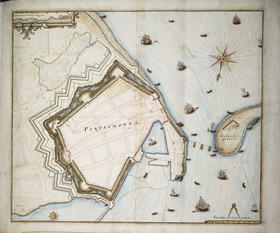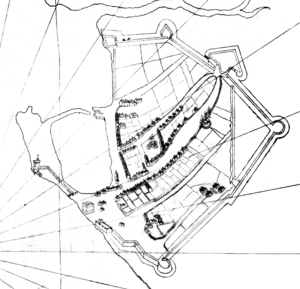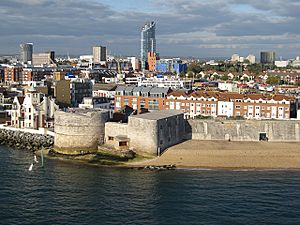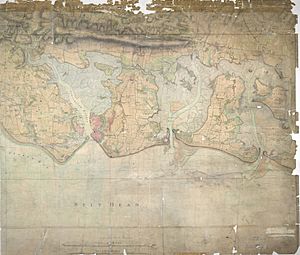Fortifications of Portsmouth facts for kids
The fortifications of Portsmouth are a huge system of defenses. Portsmouth is a very important city because it's on the English Channel and is home to the Royal Navy. This made it one of the most protected cities in the world by the 1800s.
These defenses changed over hundreds of years. They grew as new fighting methods and technology appeared. At first, the defenses only protected Portsmouth Harbour. Later, they covered all of Portsea Island and even areas further inland. The defenses of Portsmouth and Gosport also became part of a bigger system protecting the whole Solent area. The oldest part of Portsmouth, called Old Portsmouth, has had walls for most of its history.
Contents
- Early Defenses: How Portsmouth First Protected Itself
- Growing Stronger: Defenses Under the Tudors
- Portsmouth During the Civil War
- Rebuilding Under King Charles II
- 18th Century Defenses
- 19th Century: The Palmerston Forts
- 20th Century: Defenses Change Again
- Surviving Fortifications: What You Can Still See Today
- Images for kids
Early Defenses: How Portsmouth First Protected Itself
The very first defense in the area was Portchester Castle. This castle dates back to Roman times. It helped protect the inner parts of Portsmouth Harbour. The first recorded wall on Portsea Island was built in 1212. It was around a simple shipyard near what is now Camber Dock. But this wall only lasted for less than twelve years.
During the 1300s, Portsmouth was attacked several times. Simple earth walls were built and rebuilt to protect the town. The first real structure to defend Portsmouth was a wooden Round Tower. It was built between 1418 and 1426. Four years later, another wooden tower was added on the other side of the harbour.
Growing Stronger: Defenses Under the Tudors
When Henry VII was king, the Round Tower was rebuilt with stone. The Square Tower was also added. It's thought that the "saluting platform" was also built around this time. His son, Henry VIII, built Southsea Castle at the southern tip of Portsea Island.
North of the city, a small fort was likely built to protect the bridge over Portsbridge Creek. In 1522, the first of several chains was ordered. These chains could be raised to try and block the harbour entrance.
By 1542, Portsmouth was surrounded by walls and towers made of earth and wood. One tower was at a corner where the wall from the saluting platform met the southeast wall of the town. This southeast wall also had a firing platform. Another tower was built where the southeast and northeast walls met. In the middle of the northwest wall was the town gate. It was protected by a structure called The Mount, which acted like a strong point. The wall north of the town had a tower at each end. Gabions (baskets filled with earth) were built along the Camber dock. A wooden fence, called a palisade, separated Portsmouth Point from the town. A wooden wall was also built between the Round Tower and the saluting platform.
More building work started in the late 1550s and continued through the reign of Elizabeth I. From about 1560, Richard Popynjay mostly led the work. The earth walls were updated. The gabions and palisade were replaced with stone walls. Other towers were improved, some becoming strong bastions. The Mount, protecting the town gate, was rebuilt and became a true bastion. The saluting platform was also rebuilt.
During this time, many defense names started to be used that are still known today. The strong point near the saluting platform was called Green's Bulwark or Chaterton's Bulwark. Of the two towers on the north wall, the western one was the Dock Bulwark. The eastern one was Guyes Bulwark. The Mount was also known as the Great Bastion. The gate to Portsmouth Point was the North Gate. By 1571, many of these defenses needed repairs.
In the second half of Elizabeth I's reign, more work was done on the bastions. The first bridge at the Landport gate was built around 1586. There was also a lot of repair work. Around 1600, a new gate called Point Gate replaced the North Gate. It controlled access to Portsmouth Point.
Portsmouth During the Civil War
At the time of the English Civil War, Portsmouth's defenses had about 100 guns. Some people thought they could hold off an army of 40,000 men if fully staffed. In one of the first battles of the war, Parliament's forces captured the city from the Royalists during the Siege of Portsmouth.
Rebuilding Under King Charles II

In 1665, King Charles II ordered Bernard de Gomme to rebuild Portsmouth's defenses. This project took many years. The year before, a new chain was ordered to block the harbour entrance. It cost £200. Starting in 1678, Fort James was built on Burrow Island. Later, in the 1680s, Southsea Castle was rebuilt. The Portsbridge fort was also rebuilt in the same decade.
The city walls were rebuilt again. A second moat was added, with a new defensive line between the two moats. A ravelin (a triangular fort) was added at Landport, where the London road entered the city.
Along the shoreline, a new battery was built at the end of Portsmouth Point, facing Gosport. Another battery with 18 guns was built, connecting to the Round Tower. A third battery was built between the Square Tower and the saluting platform. Beyond this battery, connected by a tunnel, the Spur redoubt was built.
While the town's defenses were being made stronger, people also thought about how they looked. In 1665, Lieutenant-Governor Sir Philip Honeywood ordered trees to be planted on the town walls.
The first true fort for the dockyard was built between 1665 and 1668. Before this, it only had a wall. The new fort had an earth wall with one main strong point and two smaller ones.
Later in the 1600s, in 1688, the fort protecting the crossing over Portsbridge Creek was rebuilt. This was done under the direction of Sir Martin Beckman, the Chief Royal Engineer.
18th Century Defenses
In the 1700s, Portsea grew around the dockyard. In the 1770s, new walls and moats were built to protect this new settlement.
The defenses built by de Gomme needed a lot of people to manage them. So, after about 1730, the double moat system around Portsmouth was stopped. The outer moat was filled in.
At the same time, the defenses started to protect all of Portsea Island. The Portsbridge fort was rebuilt again in 1746. In 1756 and 1757, the first Hilsea lines were built to protect the north of Portsea Island. The first Fort Cumberland was built to stop enemies from sailing into Langstone Harbour. The first Lumps Fort and Eastney battery were built to protect Eastney beach.
19th Century: The Palmerston Forts
The most recent major defenses for the city and harbour were built after 1859. This was due to the Royal Commission on the Defence of the United Kingdom. These defenses are known as the Palmerston Forts. They include forts in the Solent, forts along the top of Portsdown Hill, forts in Gosport, and the Hilsea Lines.
Fort Cumberland and Lumps Fort were greatly rebuilt during this time.
The Portsea defenses were made a bit bigger in the 1840s and 1860s as the dockyard expanded.
However, most of the city walls were removed in the 1870s and 1880s. Convicts were used to do this hard work.
20th Century: Defenses Change Again
By the early 1900s, new artillery technology made many land-facing forts useless. By the end of the first decade, most of these forts no longer had their guns.
After World War 1, the city council started to buy various defenses from the military. In the 1920s and 1930s, the city bought much of the Hilsea lines and Lumps Fort.
During World War 2, anti-tank defense blocks were built on Fraser Beach. Small forts called pillboxes were built to defend Portsmouth Airport. These included Pickett-Hamilton Forts. The sea forts were given new anti-aircraft guns. A new concrete gun position with a 75mm gun was built on the eastern part of the Hilsea lines.
The remaining defenses were stopped when the UK no longer used coastal artillery in 1956.
Surviving Fortifications: What You Can Still See Today
Many of the defenses built on Portsea Island still exist. These include Southsea Castle, Fort Cumberland, The Round Tower, The Square Tower, Lumps Fort, parts of the Hilsea lines, the Spur Redoubt, and parts of the old Portsmouth walls along the seafront. Various forts inside the naval dockyard also remain.
Beyond Portsea, most of the Portsdown Forts are still there, though Fort Wallington has been mostly taken down.
Of the four gates in the walls of Old Portsmouth, only Landport Gate is still in its original place. King James's Gate, Lion Gate, and Unicorn Gate have been moved and rebuilt nearby.
Images for kids
The anti-tank defense blocks on Fraser Beach are now a protected historical structure. A pair of links from one of the harbour boom chains are on display at Southsea Castle. One of the Pickett-Hamilton forts built to protect the airport is now on display outside The D-Day Story in Southsea.





